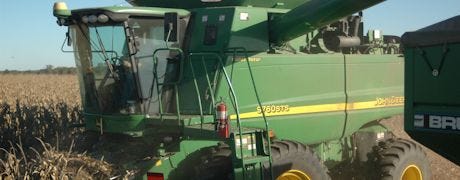
This year has been anything but ordinary. Following a wet spring and dry summer, some parts of southwest Missouri received up to 15 inches of rain in the first week of August. Further north, Bates and St. Clair Counties, where Brett Harkrader farms, received up to 9 inches of rain during this week. Although not very timely, Harkrader says it helped corn kernels fill out. "It definitely helped the corn, it just didn't come quick enough," he says. "If it would have just been a little bit earlier, I think we would have had some really good corn."

UNLOAD ON THE GO: Brett Harkrader harvesting corn on this field near Appleton City. With the abnormal weather this year, Harkrader started harvesting later than usual. In addition to the wet spring that delayed farmers across the U.S., his region received about 9 inches of rain in the first week of August, after six weeks of no rain.
Harkrader farms ground from east of Rich Hill to east of Appleton City. Like much of the Midwest, the cold, wet spring slowed planting progress in the region. "We went from a flood to a drought, to a flood to a drought again," he says. He started planting corn in mid-May, planting for a week before more rains hit. In mid-June, he had a window to finish planting. "Right after we planted in the middle of June – we planted for 4 or 5 days – we got another 2.5 inches of rain," he says. "I think the June-planted corn will yield pretty well." After the rain in June, it didn't rain for six weeks – until the beginning of August.
What is a normal year?
Harkrader normally starts harvesting corn around the end of August, although he notes, "We're almost forgetting what normal is." The late start this year pushed all farmers back. Harkrader and other farmers in the area didn't start harvesting until early October. His June-planted corn is still high in moisture, around 20% to 22% moisture, and his May-planted corn is around 16 to 17%.
So far, corn in his region is yielding 20 to 30 bushels below average, but Harkrader says it's still a lot better than the last two years of drought. His region saw a lot of corn that didn't pollinate. "Around the time the corn was trying to pollinate in early July, it was hot and dry. Most of the time we get a decent rain in July, and we didn't get anything this year," he says. "About the only thing July was good for was baling hay."
About the Author(s)
You May Also Like






